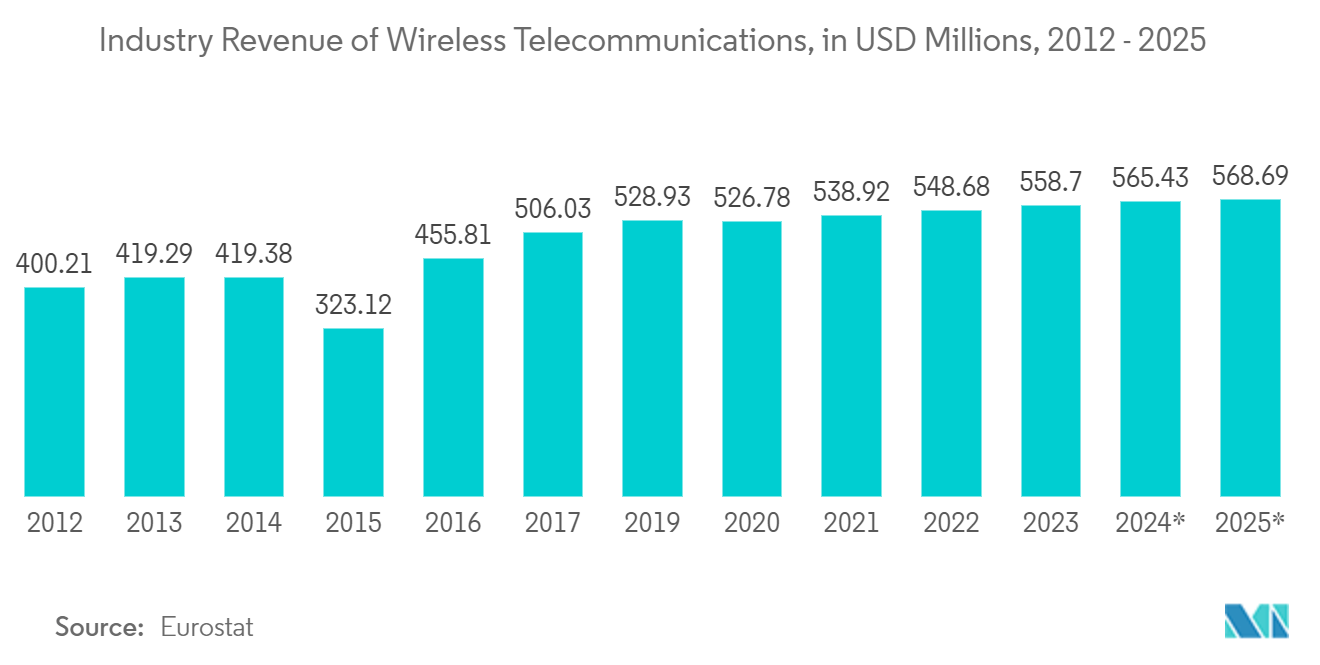Market Trends of Slovenia Telecom Industry
Rising Demand for 5G to Drive the Market
- As a participant in the EU's Connected and Automated Mobility (CAM) program, Slovenia secures funding for deploying 5G infrastructure along its primary transport routes. Notably, initiatives such as 5G-ADRIA bolstered 5G coverage between Koper and Rijeka, a move set to elevate connectivity and pave the way for advanced traffic services.
- For instance, in December 2023, the European Union unveiled the EUR 735,000 (approximately USD 679,000) 5G-ADRIA project. This initiative aims to delineate the requisite 5G infrastructure to bolster forthcoming traffic-related services along the TEN-T transport corridors of Slovenia and Croatia. Moreover, the envisioned corridor will link the primary TEN-T ports in the northern Adriatic, specifically Koper and Rijeka.
- Telemach spearheads efforts to enhance 5G infrastructure, notably in the EU-backed 5G-ADRIA project. This project specifically targets improved traffic management by bolstering 5G coverage. OpenSignal's data reveals that Telemach users enjoy the swiftest average 5G download speeds in Slovenia, clocking in at 302.5 Mbps. This speed outpaces A1's 204.2 Mbps by 48.1% and dwarfs Telekom Slovenije's 108.6 Mbps, being 2.8 times faster.
- In December 2023, the Slovenian government approved the Reconstruction, Development, and Provision of Financial Resources Act to bolster the nation's communication networks, focusing on advancing 5G technology. The Act outlines measures to support the development, including financial incentives. It earmarks funds to co-finance the construction of public communication networks, infrastructure, and the establishment of high-performance 5G mobile networks, underscoring the government's commitment to technological advancement.
- The government efforts can be understood by the fact that Slovenia assigned over 98% of its total harmonized 5G spectrum for use as of October 2023, the highest figure in Central and Eastern Europe (CEE). Czechia and Slovakia followed with approximately two-thirds of their total harmonized 5G spectrum assigned. Poland still needed to assign relevant spectrum bands for 5G.

Wireless Services are Expected to Drive the Market
- Slovenia is significantly investing in broadening its 4G and 5G network coverage. This move is pivotal in bolstering connectivity and delivering high-speed internet access, not just in urban but also in rural regions. The upgraded network infrastructure enables superior mobile data services and catalyzes the uptake of wireless services nationwide.
- For instance, in January 2024, the feasibility study for 5G-SITACOR, a CAM-based 5G corridor connecting Italy and Slovenia, was initiated. Valued at EUR 343,000 (approximately USD 317,000), the study aims to evaluate the technical prerequisites for enhancing the TEN-T Mediterranean and Baltic-Adriatic corridors. It strongly emphasizes the cross-border segments linking Italy's Friuli Venezia Giulia Region and the Republic of Slovenia.
- A1 Slovenia has significantly expanded its 5G network, prioritizing coverage in urban and rural regions. In line with its sustainability goals and network advancement, the company made a strategic move by phasing out its 3G network in June 2023, aligning with global network deployment trends.
- A1 Slovenija, a division of the A1 Telekom Group, is leading the development of the nation's most extensive 5G network. As per the company's reports, this cutting-edge technology blankets 70% of the population. A1 Slovenija aims to extend this coverage significantly, targeting an impressive 98% by the close of 2025.
- The telecommunication market in Slovenia is on the rise, with wireless telecommunication revenue projected to be USD 568.69 million by 2025, according to Eurostat, the statistical office of the European Union.


